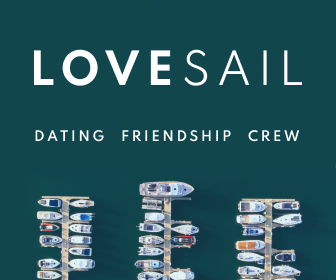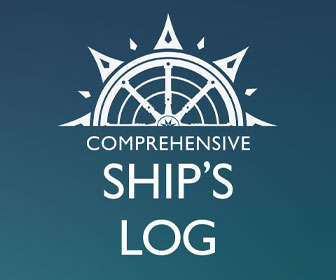Rapa Nui (Easter Island): Nothing Short of Amazing!
Canadian citizens Brent Crack and Mary Bevan, who are currently cruising through the Pacific on their catamaran, report that Rapa Nui (Easter Island) is the most incredible place they have been (so far) on their voyage. Here they tell Noonsite about their time on the Island as the first cruising yacht to visit in over a year.
Published 1 year ago
What we know as Easter Island, actually goes by another name to the locals who live there – Rapa Nui. In respecting this incredible and amazing island and its people, we will refer to it as they do.
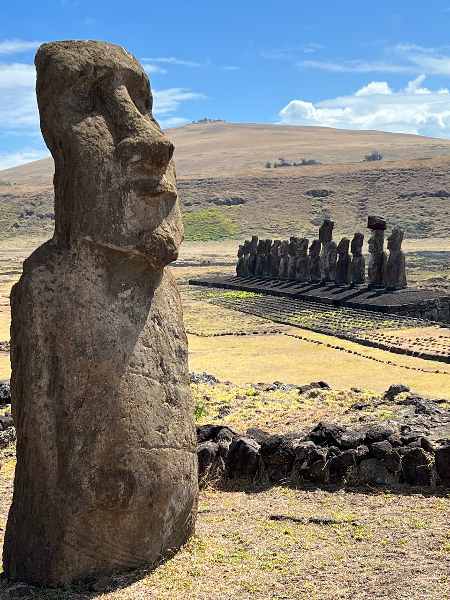
- The Rapa Nui statues are a must see on the island.
With two aboard, we departed Panama on December 1, 2022, setting sail to Rapa Nui. While we considered stopping in mainland Ecuador, new fees meant that a quick visit would be expensive. For that reason, we passed by that country (and the Galapagos also).
After a 26 day crossing and 3439 nautical miles sailed (plenty of upwind tacking at the start), we arrived at this mysterious island full of history and archeological debate and discovery.
Paperwork and Formalities:
Prior to our departure, we had spent a lot of time trying to figure out the entry requirements and fees for the island. Emails to the various Chilean government contacts had gone unanswered and we were left with contacting local tourism operators. Eventually, one responded who was kind enough to reach out to the harbour master and clearly detailed the entry requirements for us. The only thing required was a 24-hour pre-departure PCR Covid test.
Ten miles prior to arrival we attempted to notify “Pascua Radio”, but there was no response. We would later find out that there is virtually nobody calling on the radio here, especially at four in the morning!
A second call at the five mile boundary was met with an agreement to notify upon arrival. As we made the final approach to Hanga Roa (the main community on Rapa Nui), we again reached out. While “Pascua Radio” did speak English, the communication barrier was too great for us to understand due to our limited Spanish skills. Ultimately, we ended up exchanging WhatsApp contact and communicating that way.
We anchored in about 13 meters of excellent sand, approximately 500 meters in front of Hanga Roa. The anchoring guide by SV Migration was perfect for guiding us to the correct spot. Once anchored we continued our WhatsApp chat and sent copies of passports, boat registration, PCR test results and answered various questions. One thing that caused a bit of a problem is that they wanted our AIS track, but since we didn’t have satellite and were outside of radio range for so long, we were not showing on their system. A quick screenshot of our daily waypoints resolved this hiccup and within an hour we were advised that government officials would be coming to visit us on our boat.
Shortly after, eight government representatives arrived, all of whom were super friendly and resolved their paperwork in about 20 minutes. Officials included customs, immigration, agriculture, medical, financial and navy. A lot of paperwork was completed with impressive efficiency.
We were advised that we were the first cruising boat to enter the country in more than six months. They were excited we had come and were proud to represent their country. We specifically asked if someone was required to be on the boat at all times (as various guides had indicated). They were quite clear that this was not a requirement at all and we were both free to do as we wished. We asked about monitoring VHF Channel 16 at all times. They said it was not needed. That being said, we have kept it on and it has been mostly silent.
Wait and See about the Fees….
We were advised that we would be notified in a few days about paying the fees. Questions as to estimated fees were answered dismissively. Nobody seemed to know.
A few days later, a text was received that the fees were ready to be paid. Final result —$29.02 USD, for two people and a 40’ catamaran. What a pleasant surprise. One note — the fees can only be paid in USD.
…and the visitors kept coming!
Shortly after the officials left, the unofficial welcoming began. A steady stream of locals swam, paddled, or motored out to the boat to welcome us to the island. They were all so excited we were here and wanted to welcome us to their island — most of them had seen us from their houses that morning. Many said it had been more than a year since the last cruising boat had come. Little did we know, this stream of visitors would continue past the first day. All day, every day during our stay, there were visitors coming out to say hello and welcome us. Many brought us gifts of bananas, vegetables and honey (and wanted nothing in return, though we kept cold drinks at ready for these occasions). We eneded up with four hands of bananas hanging in this boat and seven incredibly sweet pineapples.
During our time on the island, we found many locals knew (or could tell) we were from the boat and they welcomed us. We noticed that our experience was quite different compared to those who had arrived by plane. The locals appreciated our means of transportation and wanted to hear how our travels went. Many of the locals shared stories of their own about traveling across the Pacific Ocean and navigating by the sun and stars, just as their ancestors had done.

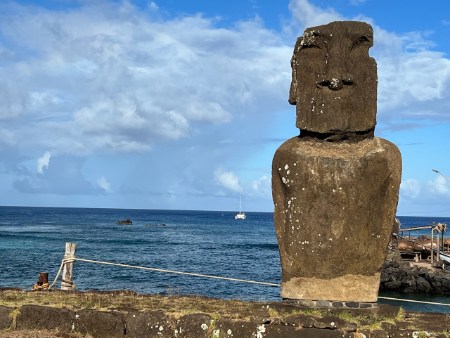
- The iconic Moai or stone statues of Rapa Nui are a spectacular sight and visible from the anchorage.
Nothing Short of Amazing!
The island is nothing short of amazing. The stone heads (Moai) are incredible and the culture that still exists is fantastic. All we can say to our friends in Canada is, “Get here, see it”. You will need to have a local guide to see some of the historical locations on the island, but for others one isn’t needed. You will also need a ticket which costs $80 USD. Most guided tours will span two days.
Supplies and provisioning on the island – nearly everything is available. Sometimes a visit to three or four stores would be necessary to find what is needed – all the while being mindful of the time of day. Prices are very reasonable considering that all goods are flown or shipped in. There is a gas station where fuel jugs can be filled and then hauled by car to the dinghy.
At the dinghy dock, a stern anchor or a long rope is a must. The area that was designated by the locals “for us” was the furthest right spot upon entrance along a concrete wall and next to rocks which children climb along. Prepare to have young kids using your dinghy as a trampoline. They mean no harm, and are just swimming in the basin, but quite like the bounciness.
All in all, Rapa Nui has been one of the best places we have visited on our voyage to date: out of the way, absolutely, but so worth the journey. We would imagine that it is much like sailing was 40 years ago with friendly people, quiet anchorages and a slow lifestyle.
Brent Crack and Mary Bevan
SV Knot Safety
………………………………………………………………………………………………………………………………………..
About the Authors:
Brent Crack and Mary Bevan are two Canadian citizens who are currently sailing across the Pacific. This 26 day odyssey was Mary’s first passage, whereas Brent has been sailing for a number of years now. They are on a Lagoon 400 catamaran and are heading for Pitcairn Island and Gambier after leaving Rapa Nui.
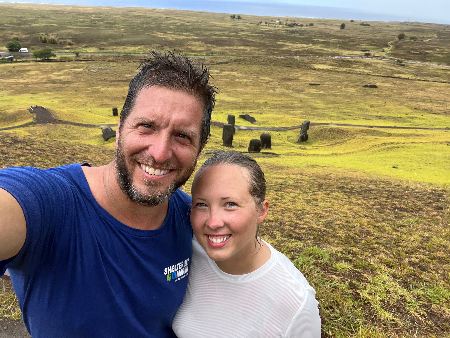

………………………………………………………………………………………………………………………………………..
The opinions expressed in this article are the author’s own and do not reflect the view of Noonsite.com or World Cruising Club.
………………………………………………………………………………………………………………………………………
See more “Off the Beaten Path” articles and resources here.
………………………………………………………………………………………………………………………………………..
Find out all news, reports, links and comments posted on Noonsite, plus cruising information from around the world, by subscribing to our FREE monthly newsletter. Go to https://www.noonsite.com/newsletter/.
Related to following destinations: Easter Island, Hanga Roa
Related to the following Cruising Resources: Off the Beaten Path, Pacific Crossing, Routing





